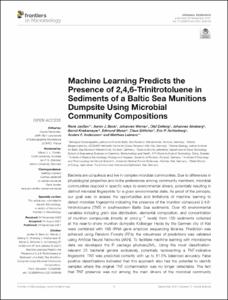Machine Learning Predicts the Presence of 2,4,6-Trinitrotoluene in Sediments of a Baltic Sea Munitions Dumpsite Using Microbial Community Compositions.

View/
Average rating
votes
Date
2021Author
Janssen, René
Beck, Aaron J.
Werner, Johannes
Dellwig, Olaf
Alneberg, Johannes
Kreikemeyer, Bernd
Maser, Edmund
Böttcher, Claus
Achterberg, Eric P.
Andersson, Anders F.
Labrenz, Matthias
Metadata
Show full item recordAbstract
Bacteria are ubiquitous and live in complex microbial communities. Due to differences in
physiological properties and niche preferences among community members, microbial
communities respond in specific ways to environmental drivers, potentially resulting in
distinct microbial fingerprints for a given environmental state. As proof of the principle,
our goal was to assess the opportunities and limitations of machine learning to
detect microbial fingerprints indicating the presence of the munition compound 2,4,6-
trinitrotoluene (TNT) in southwestern Baltic Sea sediments. Over 40 environmental
variables including grain size distribution, elemental composition, and concentration
of munition compounds (mostly at pmol g1 levels) from 150 sediments collected
at the near-to-shore munition dumpsite Kolberger Heide by the German city of Kiel
were combined with 16S rRNA gene amplicon sequencing libraries. Prediction was
achieved using Random Forests (RFs); the robustness of predicti.....
Journal
Frontiers in MicrobiologyVolume
12Issue
Article 626048Page Range
18pp.Document Language
enSustainable Development Goals (SDG)
14.1Essential Ocean Variables (EOV)
Marine debrisSpatial Coverage
Baltic SeaDOI Original
10.3389/fmicb.2021.626048Citation
Janßen, R., Beck, A.J., Werner, J., Dellwig, O., Alneberg, J.,et al (2021) Machine Learning Predicts the Presence of 2,4,6-Trinitrotoluene in Sediments of a Baltic Sea Munitions Dumpsite Using Microbial Community Compositions. Frontiers in Microbiology, 12:626048, 18pp. DOI: 10.3389/fmicb.2021.626048Collections
The following license files are associated with this item:
 Repository of community practices in Ocean Research, Applications and Data/Information Management
Repository of community practices in Ocean Research, Applications and Data/Information Management
